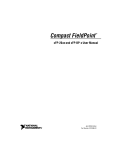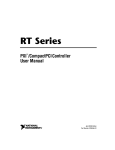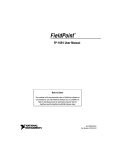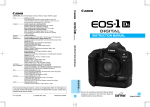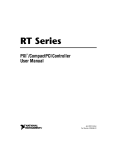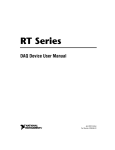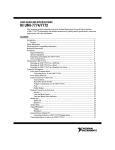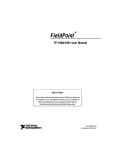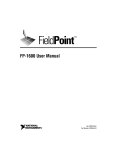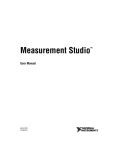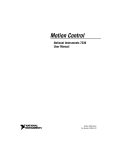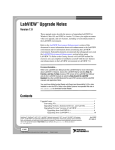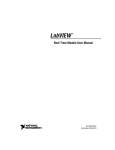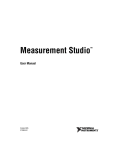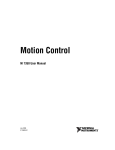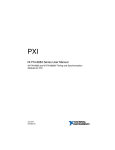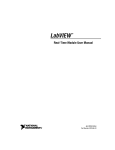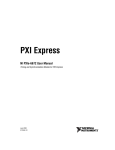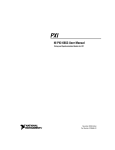Download cFP-21xx and cFP-BP-x User Manual
Transcript
Compact FieldPoint cFP-21xx and cFP-BP-x User Manual cFP-21xx and cFP-BP-x User Manual February 2005 371380B-01 TM Support Worldwide Technical Support and Product Information ni.com National Instruments Corporate Headquarters 11500 North Mopac Expressway Austin, Texas 78759-3504 USA Tel: 512 683 0100 Worldwide Offices Australia 1800 300 800, Austria 43 0 662 45 79 90 0, Belgium 32 0 2 757 00 20, Brazil 55 11 3262 3599, Canada 800 433 3488, China 86 21 6555 7838, Czech Republic 420 224 235 774, Denmark 45 45 76 26 00, Finland 385 0 9 725 725 11, France 33 0 1 48 14 24 24, Germany 49 0 89 741 31 30, India 91 80 51190000, Israel 972 0 3 6393737, Italy 39 02 413091, Japan 81 3 5472 2970, Korea 82 02 3451 3400, Lebanon 961 0 1 33 28 28, Malaysia 1800 887710, Mexico 01 800 010 0793, Netherlands 31 0 348 433 466, New Zealand 0800 553 322, Norway 47 0 66 90 76 60, Poland 48 22 3390150, Portugal 351 210 311 210, Russia 7 095 783 68 51, Singapore 1800 226 5886, Slovenia 386 3 425 4200, South Africa 27 0 11 805 8197, Spain 34 91 640 0085, Sweden 46 0 8 587 895 00, Switzerland 41 56 200 51 51, Taiwan 02 2377 2222, Thailand 662 992 7519, United Kingdom 44 0 1635 523545 For further support information, refer to the Technical Support and Professional Services appendix. To comment on National Instruments documentation, refer to the National Instruments Web site at ni.com/info and enter the info code feedback. © 2005 National Instruments Corporation. All rights reserved. Important Information Warranty The FieldPoint hardware is warranted against defects in materials and workmanship for a period of one year from the date of shipment, as evidenced by receipts or other documentation. National Instruments will, at its option, repair or replace equipment that proves to be defective during the warranty period. This warranty includes parts and labor. The media on which you receive National Instruments software are warranted not to fail to execute programming instructions, due to defects in materials and workmanship, for a period of 90 days from date of shipment, as evidenced by receipts or other documentation. National Instruments will, at its option, repair or replace software media that do not execute programming instructions if National Instruments receives notice of such defects during the warranty period. National Instruments does not warrant that the operation of the software shall be uninterrupted or error free. A Return Material Authorization (RMA) number must be obtained from the factory and clearly marked on the outside of the package before any equipment will be accepted for warranty work. National Instruments will pay the shipping costs of returning to the owner parts which are covered by warranty. National Instruments believes that the information in this document is accurate. The document has been carefully reviewed for technical accuracy. In the event that technical or typographical errors exist, National Instruments reserves the right to make changes to subsequent editions of this document without prior notice to holders of this edition. The reader should consult National Instruments if errors are suspected. In no event shall National Instruments be liable for any damages arising out of or related to this document or the information contained in it. EXCEPT AS SPECIFIED HEREIN, NATIONAL INSTRUMENTS MAKES NO WARRANTIES, EXPRESS OR IMPLIED, AND SPECIFICALLY DISCLAIMS ANY WARRANTY OF MERCHANTABILITY OR FITNESS FOR A PARTICULAR PURPOSE. CUSTOMER’S RIGHT TO RECOVER DAMAGES CAUSED BY FAULT OR NEGLIGENCE ON THE PART OF NATIONAL INSTRUMENTS SHALL BE LIMITED TO THE AMOUNT THERETOFORE PAID BY THE CUSTOMER. NATIONAL INSTRUMENTS WILL NOT BE LIABLE FOR DAMAGES RESULTING FROM LOSS OF DATA, PROFITS, USE OF PRODUCTS, OR INCIDENTAL OR CONSEQUENTIAL DAMAGES, EVEN IF ADVISED OF THE POSSIBILITY THEREOF. This limitation of the liability of National Instruments will apply regardless of the form of action, whether in contract or tort, including negligence. Any action against National Instruments must be brought within one year after the cause of action accrues. National Instruments shall not be liable for any delay in performance due to causes beyond its reasonable control. The warranty provided herein does not cover damages, defects, malfunctions, or service failures caused by owner’s failure to follow the National Instruments installation, operation, or maintenance instructions; owner’s modification of the product; owner’s abuse, misuse, or negligent acts; and power failure or surges, fire, flood, accident, actions of third parties, or other events outside reasonable control. Copyright Under the copyright laws, this publication may not be reproduced or transmitted in any form, electronic or mechanical, including photocopying, recording, storing in an information retrieval system, or translating, in whole or in part, without the prior written consent of National Instruments Corporation. Trademarks National Instruments, NI, ni.com, and LabVIEW are trademarks of National Instruments Corporation. Refer to the Terms of Use section on ni.com/legal for more information about National Instruments trademarks. Other product and company names mentioned herein are trademarks or trade names of their respective companies. Patents For patents covering National Instruments products, refer to the appropriate location: Help»Patents in your software, the patents.txt file on your CD, or ni.com/patents. WARNING REGARDING USE OF NATIONAL INSTRUMENTS PRODUCTS (1) NATIONAL INSTRUMENTS PRODUCTS ARE NOT DESIGNED WITH COMPONENTS AND TESTING FOR A LEVEL OF RELIABILITY SUITABLE FOR USE IN OR IN CONNECTION WITH SURGICAL IMPLANTS OR AS CRITICAL COMPONENTS IN ANY LIFE SUPPORT SYSTEMS WHOSE FAILURE TO PERFORM CAN REASONABLY BE EXPECTED TO CAUSE SIGNIFICANT INJURY TO A HUMAN. (2) IN ANY APPLICATION, INCLUDING THE ABOVE, RELIABILITY OF OPERATION OF THE SOFTWARE PRODUCTS CAN BE IMPAIRED BY ADVERSE FACTORS, INCLUDING BUT NOT LIMITED TO FLUCTUATIONS IN ELECTRICAL POWER SUPPLY, COMPUTER HARDWARE MALFUNCTIONS, COMPUTER OPERATING SYSTEM SOFTWARE FITNESS, FITNESS OF COMPILERS AND DEVELOPMENT SOFTWARE USED TO DEVELOP AN APPLICATION, INSTALLATION ERRORS, SOFTWARE AND HARDWARE COMPATIBILITY PROBLEMS, MALFUNCTIONS OR FAILURES OF ELECTRONIC MONITORING OR CONTROL DEVICES, TRANSIENT FAILURES OF ELECTRONIC SYSTEMS (HARDWARE AND/OR SOFTWARE), UNANTICIPATED USES OR MISUSES, OR ERRORS ON THE PART OF THE USER OR APPLICATIONS DESIGNER (ADVERSE FACTORS SUCH AS THESE ARE HEREAFTER COLLECTIVELY TERMED “SYSTEM FAILURES”). ANY APPLICATION WHERE A SYSTEM FAILURE WOULD CREATE A RISK OF HARM TO PROPERTY OR PERSONS (INCLUDING THE RISK OF BODILY INJURY AND DEATH) SHOULD NOT BE RELIANT SOLELY UPON ONE FORM OF ELECTRONIC SYSTEM DUE TO THE RISK OF SYSTEM FAILURE. TO AVOID DAMAGE, INJURY, OR DEATH, THE USER OR APPLICATION DESIGNER MUST TAKE REASONABLY PRUDENT STEPS TO PROTECT AGAINST SYSTEM FAILURES, INCLUDING BUT NOT LIMITED TO BACK-UP OR SHUT DOWN MECHANISMS. BECAUSE EACH END-USER SYSTEM IS CUSTOMIZED AND DIFFERS FROM NATIONAL INSTRUMENTS' TESTING PLATFORMS AND BECAUSE A USER OR APPLICATION DESIGNER MAY USE NATIONAL INSTRUMENTS PRODUCTS IN COMBINATION WITH OTHER PRODUCTS IN A MANNER NOT EVALUATED OR CONTEMPLATED BY NATIONAL INSTRUMENTS, THE USER OR APPLICATION DESIGNER IS ULTIMATELY RESPONSIBLE FOR VERIFYING AND VALIDATING THE SUITABILITY OF NATIONAL INSTRUMENTS PRODUCTS WHENEVER NATIONAL INSTRUMENTS PRODUCTS ARE INCORPORATED IN A SYSTEM OR APPLICATION, INCLUDING, WITHOUT LIMITATION, THE APPROPRIATE DESIGN, PROCESS AND SAFETY LEVEL OF SUCH SYSTEM OR APPLICATION. Conventions The following conventions appear in this manual: » The » symbol leads you through nested menu items and dialog box options to a final action. The sequence File»Page Setup»Options directs you to pull down the File menu, select the Page Setup item, and select Options from the last dialog box. This icon denotes a note, which alerts you to important information. This icon denotes a caution, which advises you of precautions to take to avoid injury, data loss, or a system crash. When this symbol is marked on the product, refer to the Read Me First: Safety and Radio-Frequency Interference document, shipped with the product, for precautions to take. bold Bold text denotes items that you must select or click in the software, such as menu items and dialog box options. Bold text also denotes parameter names and LED names. cFP-21xx cFP-21xx refers to the cFP-2100, cFP-2110, and cFP-2120. italic Italic text denotes variables, emphasis, a cross reference, or an introduction to a key concept. This font also denotes text that is a placeholder for a word or value that you must supply. monospace Text in this font denotes text or characters that you should enter from the keyboard, sections of code, programming examples, and syntax examples. This font is also used for the proper names of disk drives, paths, directories, programs, subprograms, subroutines, device names, functions, operations, variables, filenames, and extensions. monospace italic Italic text in this font denotes text that is a placeholder for a word or value that you must supply. Contents Chapter 1 Overview of Compact FieldPoint cFP-21xx Compact FieldPoint Controller Overview .....................................................1-1 FieldPoint Software Overview.......................................................................................1-3 cFP-21xx Setup Overview .............................................................................................1-3 Chapter 2 Installing Compact FieldPoint Hardware and Software What You Need to Get Started ......................................................................................2-1 Compact FieldPoint Safety Information ........................................................................2-2 Mounting the Compact FieldPoint Backplane...............................................................2-4 Mounting the Backplane on a Panel................................................................2-6 Mounting the Backplane in a Standard 19-in. Rack........................................2-8 Installing a DIN Rail in the Rack-Mount Accessory ........................2-10 Mounting the cFP-BP-4 on a DIN Rail ...........................................................2-11 Installing the cFP-21xx Controller on a Compact FieldPoint Backplane ......................2-12 Installing I/O Modules on the Backplane ......................................................................2-13 Connecting to Field Devices..........................................................................................2-14 Installing Connector Blocks on the Backplane..............................................................2-15 Connecting the cFP-21xx to a Network .........................................................................2-16 Wiring Power to the Compact FieldPoint System .........................................................2-16 Powering Up the cFP-21xx ............................................................................................2-17 Installing Software on the Host PC................................................................................2-18 Configuring the Compact FieldPoint System in MAX..................................................2-18 Chapter 3 Feature Descriptions Guarding against Network Failures (Network Watchdog) ............................................3-1 Guarding against Other System Failures (Hardware Watchdog) ..................................3-1 Storing a Custom Power-Up Configuration...................................................................3-2 Setting a Power-Up State with the Snapshot Feature......................................3-2 Configurable Power-Up States ........................................................................3-2 Inserting, Removing, and Replacing I/O Modules ........................................................3-2 © National Instruments Corporation v cFP-21xx and cFP-BP-x User Manual Contents LED Indicators .............................................................................................................. 3-3 POWER LED .................................................................................................. 3-3 STATUS LED................................................................................................. 3-3 LINK ACT LED ............................................................................................. 3-3 100 Mbps LED................................................................................................ 3-4 User-Configurable LEDs A–D........................................................................ 3-4 Power-On Self Test (POST) ........................................................................... 3-4 DIP Switches ................................................................................................................. 3-5 CONSOLE OUT Switch ................................................................................. 3-6 DISABLE VI Switch ...................................................................................... 3-6 SAFE MODE Switch ...................................................................................... 3-6 RESET IP Switch............................................................................................ 3-7 Serial Ports ...................................................................................................... 3-7 COM 1............................................................................................................. 3-7 COM 2 (cFP-2110 and cFP-2120 Only) ......................................................... 3-8 COM 3 (cFP-2120 Only) ................................................................................ 3-8 COM 4 (cFP-2120 Only) ................................................................................ 3-8 External Switch Inputs and LED Outputs (cFP 2120 Only) ......................................... 3-10 Power Source (Isolated Power Connector).................................................................... 3-11 Removable Compact Flash (cFP-2120 Only)................................................................ 3-11 File Transfer Capability................................................................................................. 3-12 Remote Front Panels...................................................................................................... 3-12 Chapter 4 LabVIEW Real-Time Programming Targeting LabVIEW Real-Time to a Platform.............................................................. 4-1 Targeting LabVIEW Real-Time to the cFP-21xx ........................................... 4-1 Targeting LabVIEW Real-Time to the Host PC ............................................. 4-3 RT Target Options......................................................................................................... 4-3 RT Target: Access........................................................................................... 4-4 RT Target: Miscellaneous............................................................................... 4-6 Embedding Applications on the cFP-21xx .................................................................... 4-7 Command Line Arguments ............................................................................. 4-8 Using Application Builder .............................................................................. 4-8 Target Tab......................................................................................... 4-9 Source Files and VI Settings Tabs.................................................... 4-10 Application Settings and Installer Settings Tabs .............................. 4-10 Launching Embedded Applications at Startup .............................................................. 4-10 cFP-21xx and cFP-BP-x User Manual vi ni.com Contents Chapter 5 Accessing cFP-21xx Channels from PC Applications Using the cFP-21xx from PC Applications....................................................................5-1 LabVIEW VIs and the cFP-21xx.....................................................................5-1 LabWindows/CVI Functions and the cFP-21xx ..............................................5-1 FieldPoint OPC Server and the cFP-21xx .......................................................5-2 Data Communications .....................................................................................5-3 DataSocket ........................................................................................5-4 Publish Data VI .................................................................................5-5 Serial VIs...........................................................................................5-6 TCP and UDP VIs.............................................................................5-6 Appendix A Troubleshooting Appendix B Specifications Appendix C Technical Support and Professional Services Glossary Index © National Instruments Corporation vii cFP-21xx and cFP-BP-x User Manual Overview of Compact FieldPoint 1 This chapter provides an overview of the cFP-21xx Compact FieldPoint controller and FieldPoint software. cFP-21xx Compact FieldPoint Controller Overview Using the cFP-21xx controller with LabVIEW Real-Time provides an easy-to-use system for real-time embedded applications. When you run the LabVIEW Real-Time Engine on a cFP-21xx, the controller can run applications without a host PC. If you connect the cFP-21xx to an Ethernet network, you can use a separate host PC running Windows to display measurement results and status information and change the settings of the controller. Refer to the LabVIEW Help for more information about the LabVIEW Real-Time Engine. Besides the Ethernet port, the cFP-21xx has one or more RS-232 serial ports accessible through software. It also has LED indicators to communicate status information and DIP switches that perform various functions. The cFP-2120 also has a software-accessible RS-485 port and switch input/LED output for connecting to external devices such as LED status indicators and start/stop buttons. Figure 1-1 shows where all of these features are located on the cFP-21xx. The figure indicates which features are available only on specific models such as the cFP-2120. © National Instruments Corporation 1-1 cFP-21xx and cFP-BP-x User Manual Chapter 1 Overview of Compact FieldPoint Compact FieldPoint cFP-21xx POWER STATUS A 3 4 B C D 5 9 COM 4 / RS-485 COM 3 / RS-232 COM 1/RS-232 RESET 2 1 C O2 10 C O1 8 C INPUT 11-30 V-1.5 A MAX ETHERNET LINK ACT 6 C I2 11 C 7 I1 V1 COM 2 / RS-232 DI / DO V2 100 Mbps Front 1 2 3 4 5 6 Ethernet Port RS-232 Serial Port Removable Compact Flash (cFP-2120 Only) LED Indicators DIP Switches Reset Switch Bottom 7 8 9 10 11 Power Connector Switch Input/LED Output Terminals (cFP-2120 Only) RS-485 Serial Port (cFP-2120 Only) RS-232 Serial Port (cFP-2120 Only) RS-232 Serial Port (cFP-2110 and cFP-2120) Figure 1-1. cFP-21xx Parts Locator Diagram A Compact FieldPoint system consists of one cFP-BP-x backplane, one cFP-21xx controller, one or more I/O modules, and one or more connector blocks or accessories. Each Compact FieldPoint system can be accessed by an unlimited number of PCs and controllers, forming a distributed computing system. The maximum number of cFP-21xx controllers that you can install on an Ethernet network is limited only by network topology. The cFP-21xx controller connects directly to a 10 or 100 Mbps Ethernet network. The cFP-21xx auto-detects the speed of the connection and configures itself accordingly. cFP-21xx and cFP-BP-x User Manual 1-2 ni.com Chapter 1 Overview of Compact FieldPoint For detailed hardware specifications and cabling information, refer to Appendix B, Specifications. FieldPoint Software Overview FieldPoint software includes NI Measurement & Automation Explorer (MAX) as well as server and driver software for easy integration into application software packages. These software components manage the low-level communications and hardware details, simplifying programmatic access to I/O channels. FieldPoint software runs on Windows 2000/NT 4.0 Service Pack 6+/XP and includes the following components: • MAX • LabVIEW VIs • LabWindows™/CVI™ Functions • Measurement Studio instrument drivers • OPC Server • VI Logger support You can download a current version of FieldPoint software from the National Instruments Web site. Using your Web browser, go to ni.com, select Support»Drivers and Updates»Current Software Versions» Distributed I/O—FieldPoint, then select the latest version of NI-FieldPoint. cFP-21xx Setup Overview The following list is an overview of the steps required to get started with the cFP-21xx and LabVIEW Real-Time. 1. © National Instruments Corporation Install hardware as described in Chapter 2, Installing Compact FieldPoint Hardware and Software. a. Mount backplane on a panel, DIN rail, or standard 19-in. rack. b. Mount cFP-21xx and I/O modules on backplane. c. Connect cFP-21xx to network. 1-3 cFP-21xx and cFP-BP-x User Manual Chapter 1 Overview of Compact FieldPoint 2. 3. Install software as described in Chapter 2, Installing Compact FieldPoint Hardware and Software. a. Install programming software (LabVIEW Real-Time). b. Install FieldPoint software. Configure Compact FieldPoint system and verify configuration as described in the Measurement & Automation Explorer Help for FieldPoint. a. Configure cFP-21xx network settings. b. Configure I/O module ranges and settings. c. Configure security. d. Connect input signals and loads to I/O modules. e. Test channels. f. Save settings. 4. Configure optional settings as described in Chapter 3, Feature Descriptions. 5. Develop application as described in Chapter 4, LabVIEW Real-Time Programming. 6. cFP-21xx and cFP-BP-x User Manual a. Launch LabVIEW Real-Time. b. Build basic application. c. Switch execution target to test application on cFP-21xx. d. Embed application by building .exe with LabVIEW Real-Time targeted to cFP-21xx. e. Test embedded application. Deploy system. 1-4 ni.com Installing Compact FieldPoint Hardware and Software 2 This chapter explains how to install the Compact FieldPoint hardware and software. What You Need to Get Started To set up and use LabVIEW Real-Time with the cFP-21xx, you need the following: ❑ cFP-21xx Compact FieldPoint controller ❑ cFP-BP-x backplane ❑ Mounting hardware (DIN rail, panel-mount, or rack-mount accessory) ❑ cFP I/O module(s) ❑ Wiring accessories such as cFP-CB-x connector block(s) or cables ❑ 11–30 VDC power supply (20 W recommended) ❑ Ethernet cable ❑ 1/8 in. flathead and number 2 Phillips screwdrivers ❑ NI-FieldPoint software version 4.1.1 ❑ A host PC running Windows 2000/NT 4.01/XP ❑ LabVIEW Real-Time software 1 Using FieldPoint software with Windows NT 4.0 requires Service Pack 6 or later. © National Instruments Corporation 2-1 cFP-21xx and cFP-BP-x User Manual Chapter 2 Installing Compact FieldPoint Hardware and Software ❑ Optional accessories – 37-pin I/O cables – Serial cables – DIN-rail terminal blocks Compact FieldPoint Safety Information The following section contains important safety information that you must follow when installing and using Compact FieldPoint products. Do not operate the Compact FieldPoint product in a manner not specified in the user manual or operating instructions. Misuse of the product can result in a hazard. You can compromise the safety protection built into the product if the product is damaged in any way. If the product is damaged, return it to National Instruments for repair. Do not substitute parts or modify the Compact FieldPoint product. Use the product only with the modules, accessories, and cables specified in the installation instructions. You must connect the protective earth (PE) ground terminal on the cFP-BP-x backplane to the system safety ground. The backplane PE ground terminal has the following symbol stamped beside it: . Connect the backplane PE ground terminal to the system safety ground using 14 AWG (1.6 mm) wire with a ring lug. Use the 5/16 in. panhead screw shipped with the backplane to secure the ring lug to the backplane PE ground terminal. Do not operate Compact FieldPoint products in an explosive atmosphere or where there may be flammable gases or fumes. If you need to operate Compact FieldPoint products in such an environment, the Compact FieldPoint products must be in a suitably rated enclosure. If you need to clean a Compact FieldPoint product, use a soft nonmetallic brush. The product must be completely dry and free from contaminants before you return it to service. Operate the product only at or below Pollution Degree 2. Pollution is foreign matter in a solid, liquid, or gaseous state that can reduce dielectric strength or surface resistivity. The following is a description of pollution degrees: • cFP-21xx and cFP-BP-x User Manual Pollution Degree 1 means no pollution or only dry, nonconductive pollution occurs. The pollution has no influence. 2-2 ni.com Chapter 2 Installing Compact FieldPoint Hardware and Software • Pollution Degree 2 means that only nonconductive pollution occurs in most cases. Occasionally, however, a temporary conductivity caused by condensation must be expected. • Pollution Degree 3 means that conductive pollution occurs, or dry, nonconductive pollution occurs which becomes conductive due to condensation. Caution You must insulate signal connections for the maximum voltage for which the Compact FieldPoint product is rated. Do not exceed the maximum ratings for the product. Do not install wiring while the product is live with electrical signals. Do not remove or add connector blocks when power is connected to the Compact FieldPoint system. Avoid contact between your body and the connector block signal wiring when hot-swapping modules. Operate Compact FieldPoint products at or below the installation category1 marked on the hardware label. Measurement circuits are subjected to working voltages2 and transient stresses (overvoltage) from the circuit to which they are connected during measurement or test. Installation categories establish standard impulse withstand voltage levels that commonly occur in electrical distribution systems. The following is a description of installation categories: 1 2 3 • Installation Category I is for measurements performed on circuits not directly connected to the electrical distribution system referred to as MAINS3 voltage. This category is for measurements of voltages from specially protected secondary circuits. Such voltage measurements include signal levels, special equipment, limited-energy parts of equipment, circuits powered by regulated low-voltage sources, and electronics. • Installation Category II is for measurements performed on circuits directly connected to the electrical distribution system. This category refers to local-level electrical distribution, such as that provided by a standard wall outlet (for example, 115 V for U.S. or 230 V for Europe). Examples of Installation Category II are measurements performed on household appliances, portable tools, and similar products. • Installation Category III is for measurements performed in the building installation at the distribution level. This category refers to measurements on hard-wired equipment such as equipment in fixed Installation categories, also referred to as measurement categories, are defined in electrical safety standard IEC 61010-1. Working voltage is the highest rms value of an AC or DC voltage that can occur across any particular insulation. MAINS is defined as a hazardous live electrical supply system that powers equipment. Suitably rated measuring circuits may be connected to the MAINS for measuring purposes. © National Instruments Corporation 2-3 cFP-21xx and cFP-BP-x User Manual Chapter 2 Installing Compact FieldPoint Hardware and Software installations, distribution boards, and circuit breakers. Other examples are wiring, including cables, bus-bars, junction boxes, switches, socket-outlets in the fixed installation, and stationary motors with permanent connections to fixed installations. • Installation Category IV is for measurements performed at the primary electrical supply installation (<1,000 V). Examples include electricity meters and measurements on primary overcurrent protection devices and on ripple control units. Mounting the Compact FieldPoint Backplane You can mount the cFP-BP-x backplane on a panel or in a standard 19 in. rack. You can mount the cFP-BP-4 on a 35 mm DIN rail. The following sections contain instructions for all three mounting methods. Before using any of these mounting methods, record the serial number from the back of the backplane. You will be unable to read the serial number after you have mounted the backplane. To ensure maximum cooling efficiency, mount the Compact FieldPoint system so that the I/O module vents are at the top and bottom. Up Figure 2-1. cFP-BP-4 Backplane Properly Mounted As you mount the backplane, keep in mind the following requirements for space and cabling clearance: Caution • Allow 51–76 mm (2–3 in.) all around the backplane for air circulation. • Allow 76 mm (3 in.) in front of the controller and 38 mm (1.5 in.) below the controller for cabling clearance. cFP-21xx and cFP-BP-x User Manual 2-4 ni.com Chapter 2 Installing Compact FieldPoint Hardware and Software Cabling Clearance Min. 182 mm [7.18 in.] COM 4 / RS-485 COM 3 / RS-232 106 mm [4.18 in.] C O2 C O1 C I2 C I1 COM 2 / RS-232 DI / DO Cooling Outline 50.8 mm [2.00 in.] cFP-BP-4: 246 mm (9.68 in.) cFP-BP-8: 441 mm (17.4 in.) Cooling Outline 50.8 mm [2.00 in.] Figure 2-2. cFP-BP-x Backplane with cFP-21xx Installed, Bottom View with Dimensions cFP-BP-4246 mm (9.68 in.) cFP-BP-8441 mm (17.4 in.) 127 mm (5.00 in.) Min 165 mm (6.50 in.) Cabling Clearance Cooling Outline 51–76 mm (2–3 in.) All Around Figure 2-3. cFP-BP-x Backplane with cFP-21xx Installed, Front View with Dimensions © National Instruments Corporation 2-5 cFP-21xx and cFP-BP-x User Manual Chapter 2 Installing Compact FieldPoint Hardware and Software Caution NI recommends that you use one of the mounting systems described in this document. If you decide to use a custom mounting solution, make sure that the screws you use are short enough to fit in the holes in the backplane. The screw holes are 5 mm (0.2 in) deep. Mounting the Backplane on a Panel The cFP-BP-x backplane is shipped with a panel-mount kit. Complete the following steps to mount the backplane on a panel: 1. Fasten the two plates of the panel-mount kit to the back of the cFP-BP-x using a number 2 Phillips screwdriver and the 8-32 × 5/16 in. countersink screws shipped with the kit. These screws have a nylon coating to prevent them from loosening. Refer to Figures 2-4 and 2-5. Caution Do not use screws longer than 5/16 in. to fasten the panel-mount plates to the backplane. L NA NTS TIO E NATRUM INS Figure 2-4. Fastening the Panel-Mount Plates to the cFP-BP-4 Backplane 2. cFP-21xx and cFP-BP-x User Manual Bolt or screw the panel-mount accessory to a panel using 8-32 or M4 screws. 2-6 ni.com Chapter 2 127 mm (5.0 in.) Installing Compact FieldPoint Hardware and Software 102 mm (4 in.) 260.4 mm (10.25 in.) 279 mm (11.0 in.) Figure 2-5. The cFP-BP-4 Backplane with Panel-Mount Accessory 102 mm 127 mm (4.0 in.) (5.0 in.) 457 mm (18.0 in.) 476 mm (18.7 in.) Figure 2-6. The cFP-BP-8 Backplane with Panel-Mount Accessory 3. Caution Connect the safety ground as explained in the Compact FieldPoint Safety Information section. Disconnect power before removing the backplane from the panel. As shown in Figures 2-5 and 2-6, the horizontal panel-mount kit shipped with the backplane extends about 3/4 in. from each side of the backplane. NI also offers a vertical panel-mount kit that extends from the top and bottom of the backplane and is flush with the sides. The vertical panel-mount kit is part number 778688-01. Note © National Instruments Corporation 2-7 cFP-21xx and cFP-BP-x User Manual Chapter 2 Installing Compact FieldPoint Hardware and Software Mounting the Backplane in a Standard 19-in. Rack In order to mount the cFP-BP-x backplane in an EIA standard 19-in. rack, you need the rack-mount kit. You can order the kit, part number 778615-01, from NI. Figure 2-7. Dimensions of Compact FieldPoint Rack-Mount Kit, Part Number 778615-01 Complete the following steps to mount the backplane in a rack: 1. cFP-21xx and cFP-BP-x User Manual Fasten the rack-mount bracket to the back of the cFP-BP-x using the captive screws on the bracket. Refer to Figures 2-8 and 2-9. 2-8 ni.com Chapter 2 Installing Compact FieldPoint Hardware and Software AL TS TION EN NA RUM INST Figure 2-8. Fastening the Rack-Mount Accessory to the cFP-BP-4 Backplane AL TS TION EN NA RUM INST Figure 2-9. Fastening the Rack-Mount Accessory to the cFP-BP-8 Backplane © National Instruments Corporation 2-9 cFP-21xx and cFP-BP-x User Manual Chapter 2 Installing Compact FieldPoint Hardware and Software Caution 2. Bolt the rack-mount accessory to a standard 19 in. rack. 3. Connect the safety ground as explained in the Compact FieldPoint Safety Information section. Disconnect power before removing the backplane from the rack. Installing a DIN Rail in the Rack-Mount Accessory If you are using a rack-mounted cFP-BP-4, you can install a short (approximately 8 in.) DIN rail to the right of the backplane for mounting power supplies, terminal blocks, or other accessories. Refer to Figure 2-10. 1 2 3 4 1 2 cFP-BP-4 Backplane Screw Holes 3 4 Short DIN Rail for Power Supply #10-32 Screws, 3/8–1/2 in. Figure 2-10. Installing a Small DIN Rail in the Rack-Mount Accessory You can install a 16 in. DIN rail in another rack-mount accessory if you need more DIN rail space. cFP-21xx and cFP-BP-x User Manual 2-10 ni.com Chapter 2 Installing Compact FieldPoint Hardware and Software Mounting the cFP-BP-4 on a DIN Rail You can mount the cFP-BP-4 backplane on a standard 35 mm DIN rail using the DIN rail clip, NI part number 778614-01. NI does not recommend mounting the cFP-BP-8 on a DIN rail. Complete the following steps to mount the cFP-BP-4 on a DIN rail: 1. Caution Fasten the DIN rail clip to the cFP-BP-4 using a number 2 Phillips screwdriver and the 8-32 × 5/16 in. countersink screws shipped with the DIN rail clip(s). These screws have a nylon coating to prevent them from loosening. Refer to Figure 2-11. Do not use screws longer than 5/16 in. to fasten the DIN rail clip to the backplane. L NA NTS TIO E NATRUM INS Figure 2-11. Fastening the DIN Rail Clip to the cFP-BP-4 Backplane 2. © National Instruments Corporation Insert one edge of the DIN rail into the deeper opening of the DIN rail clip, as shown in Figure 2-12. 2-11 cFP-21xx and cFP-BP-x User Manual Chapter 2 Installing Compact FieldPoint Hardware and Software 1 2 3 1 DIN Rail Clip 2 DIN Rail Clip Spring 3 DIN Rail Figure 2-12. One Edge of DIN Rail Inserted in Clip Caution 3. Press down firmly on the backplane to compress the spring until the clip locks in place on the DIN rail. 4. Connect the safety ground as explained in the Compact FieldPoint Safety Information section. Disconnect power before removing the backplane from the DIN rail. Installing the cFP-21xx Controller on a Compact FieldPoint Backplane Make sure that no power is connected to the controller or the backplane. Refer to Figure 2-13 and follow these steps: 1. Make sure that the cFP-21xx controller is right side up, with the NI logo at the top, and align the captive screws on the controller with the holes on the backplane. 2. Seat the card edge at the back of the controller in the card-edge connector on the backplane. 3. Press the controller firmly to seat it on the backplane. 4. Using a number 2 Phillips screwdriver with a shank of at least 64 mm (2.5 in.) length, tighten the captive screws to 1.1 N ⋅ m (10 lb ⋅ in.) of torque. The nylon coating on the screws prevents them from loosening. cFP-21xx and cFP-BP-x User Manual 2-12 ni.com Chapter 2 Installing Compact FieldPoint Hardware and Software 5 6 7 4 1 N INSATION TR AL UM EN TS 5 4 3 2 1 2 3 4 cFP-21xx Controller Serial Number Label Write-On Address Label Captive Screws 5 6 7 Screw Holes Card-Edge Connector cFP-BP-4 Backplane Figure 2-13. Installing the cFP-21xx Controller on the Backplane (cFP-BP-4 Shown) Installing I/O Modules on the Backplane 1. Align the captive screws on the I/O module with the holes on the backplane. Alignment keys on the I/O module prevent backward insertion. 2. Press firmly to seat the I/O module on the backplane. 3. Using a number 2 Phillips screwdriver with a shank of at least 64 mm (2.5 in.) length, tighten the captive screws to 1.1 N ⋅ m (10 lb ⋅ in.) of torque. The nylon coating on the screws prevents them from loosening. © National Instruments Corporation 2-13 cFP-21xx and cFP-BP-x User Manual Chapter 2 Installing Compact FieldPoint Hardware and Software 3 4 2 1 3 2 1 2 cFP I/O Module Captive Screws 3 4 Screw Holes cFP-BP-4 Backplane Figure 2-14. Installing an I/O Module on the Backplane (cFP-BP-4 Shown) 4. Repeat this procedure to install additional I/O modules on the backplane. Connecting to Field Devices Use cFP-CB-x connector blocks or Compact FieldPoint cabling accessories to connect the I/O modules to field devices. Refer to the operating instructions for the I/O modules, connector blocks, and cabling accessories. cFP-21xx and cFP-BP-x User Manual 2-14 ni.com Chapter 2 Installing Compact FieldPoint Hardware and Software Installing Connector Blocks on the Backplane In order to connect I/O modules to input signals or to external loads, you need to install a cFP-CB-x connector block or other connectivity accessory for each I/O module on the backplane. Use the connector socket to the right of each I/O module socket. 1. Align the captive screws on the connector block with the holes on the backplane. The shape of the I/O connector on the connector block prevents backward insertion. 2. Press firmly to seat the connector block on the backplane. 3. Using a number 2 Phillips screwdriver with a shank of at least 64 mm (2.5 in.) length, tighten the captive screws to 1.1 N ⋅ m (10 lb ⋅ in.) of torque. The nylon coating on the screws prevents them from loosening. 2 3 4 1 3 1 2 cFP-CB-x Connector Block cFP I/O Module 3 4 Screw Holes Connector Slot Figure 2-15. Installing a cFP-CB-x Connector Block 4. © National Instruments Corporation Repeat this procedure to install additional connector blocks on the backplane. 2-15 cFP-21xx and cFP-BP-x User Manual Chapter 2 Installing Compact FieldPoint Hardware and Software Connecting the cFP-21xx to a Network Connect the cFP-21xx controller to an Ethernet network using the RJ-45 Ethernet port on the module. Use a standard Category 5 Ethernet cable to connect the cFP-21xx to an Ethernet hub, or use an Ethernet crossover cable to connect the module directly to a computer. Caution To prevent data loss and to maintain the integrity of your Ethernet installation, do not use a cable longer than 100 m. If you are using a 100 Mbps Ethernet, NI recommends using a Category 5 shielded twisted-pair Ethernet cable. The host PC communicates with the cFP-21xx over a standard Ethernet connection. If the host PC is already configured on a network, you must configure the cFP-21xx on the same network. If neither is connected to a network, you can connect the two directly using a CAT-5 crossover cable. If you need to build your own cable, refer to the Cabling section of Appendix B, Specifications, for more information about Ethernet cable wiring connections. In order to configure the cFP-21xx, it must reside on the same subnet as the host PC. If you want to use the cFP-21xx on a subnet other than the one the host PC is on, first connect and configure it on the same subnet as the host PC, then reassign a static IP address for the subnet where you want it to be and physically move it to the other subnet. Contact your network administrator if you need assistance configuring the host PC and cFP-21xx on the same subnet. Wiring Power to the Compact FieldPoint System Each cFP-21xx on your network requires an 11–30 VDC power supply. NI recommends the PS-5 power supply for most Compact FieldPoint applications. The cFP-21xx filters and regulates the supplied power and provides power for all the I/O modules on the backplane. Refer to the documentation for the individual I/O modules to determine whether they require any additional power in your applications. Figure 2-16 shows the 6-pin screw-terminal power connector on the cFP-21xx. cFP-21xx and cFP-BP-x User Manual 2-16 ni.com Chapter 2 Installing Compact FieldPoint Hardware and Software C V1 V2 Figure 2-16. cFP-21xx Power Connector Caution 1. Connect the positive lead of the primary power supply to one of the V1 terminals and the negative lead to one of the C terminals. 2. If you are using a backup power supply, connect the positive lead to V2 and the negative lead to one of the C terminals. The cFP-21xx generally uses the power supply with the higher voltage level. V2 is isolated from the other V terminals. 3. If module-to-module isolation is important in your application, use a separate power supply for each module that needs external power. If your application does not require module-to-module isolation, you can cascade power, using the same power supply for all modules that require external power. Cascading power defeats isolation between the cascaded modules. 4. Refer to the operating instructions for the power requirements of each I/O module. If a module requires external power, connect a power supply to the appropriate input terminals on the connector block. If you want to power field I/O devices from a connector block, supply power to the connector block, and then connect the connector block output terminals to the field device. Powering Up the cFP-21xx Check the DIP switches on the controller, making sure that the RESET IP switch is not enabled. Refer to Chapter 3, Feature Descriptions, for a description of the DIP switches. Plug in each power supply to the Compact FieldPoint system. The cFP-21xx runs a power-on self test (POST) that takes several seconds. You should see the POWER and STATUS LEDs come on. After about five seconds, the STATUS LED begins flashing. The cFP-21xx is ready to be configured, and you can install the FieldPoint software. © National Instruments Corporation 2-17 cFP-21xx and cFP-BP-x User Manual Chapter 2 Installing Compact FieldPoint Hardware and Software If you have already assigned an IP address to the cFP-21xx, the STATUS LED turns off, the I/O module READY LEDs come on, and the cFP-21xx is ready for use. The total boot time for a configured system is 15–20 seconds. If the STATUS LED does not light up as described here, refer to the STATUS LED Error Indications section of Appendix A, Troubleshooting. Installing Software on the Host PC The cFP-21xx has the embedded LabVIEW Real-Time Engine and FieldPoint software pre-installed, but you must install the necessary software on the host PC. Follow these steps to install the FieldPoint software on the host PC. 1. Install the software packages you plan to use, such as LabVIEW, LabVIEW Real-Time, Lookout, Measurement Studio, VI Logger, or LabWindows/CVI, before you install the FieldPoint software. The FieldPoint software installation installs the LabVIEW VIs and examples and the LabWindows/CVI instrument driver only if it finds the corresponding development software installed. 2. Close all other applications. 3. Insert the FieldPoint software CD into the CD-ROM drive on your computer. 4. Follow the onscreen instructions to complete the installation. If the setup does not launch automatically, select Start»Run from Windows, enter either d:\setup or d:\autorun, where d is the letter of your CD-ROM drive, and select OK. Note Configuring the Compact FieldPoint System in MAX Refer to the Measurement & Automation Explorer Help for FieldPoint for information about configuring the Compact FieldPoint system in MAX. cFP-21xx and cFP-BP-x User Manual 2-18 ni.com 3 Feature Descriptions Guarding against Network Failures (Network Watchdog) The network watchdog feature of the cFP-21xx enables you to guard your system against failures in the network connection, cables, or host computer. If the network watchdog is enabled and the cFP-21xx loses communication with all hosts or clients over the network, the cFP-21xx sets output channels to predefined values (the watchdog state). The network watchdog is disabled by default. National Instruments recommends leaving the network watchdog disabled when you are running embedded applications on the cFP-21xx. Refer to the section of this chapter for information about the hardware watchdog for embedded applications. Note Network watchdog output values can be different than power-up output values. For example, you may want to turn an output value on when you power up, but turn it off if network communication is lost. Refer to the Measurement & Automation Explorer Help for FieldPoint for information about enabling and configuring the network watchdog. Guarding against Other System Failures (Hardware Watchdog) In addition to the network watchdog, the cFP-21xx controller supports a hardware watchdog that you can set up in LabVIEW Real-Time. The hardware watchdog enables the controller to respond in predetermined ways to failures in the system. The VIs to control the hardware watchdog are on the LabVIEW Real-Time palette. © National Instruments Corporation 3-1 cFP-21xx and cFP-BP-x User Manual Chapter 3 Feature Descriptions Storing a Custom Power-Up Configuration Setting a Power-Up State with the Snapshot Feature The Snapshot feature stores the current state of the Compact FieldPoint hardware for use as the power-up state of the system. Caution Using the Snapshot feature overwrites any power-up values you have specified for individual channels. Refer to the Measurement & Automation Explorer Help for FieldPoint for information about using the Snapshot feature. Configurable Power-Up States With the configurable power-up state feature, you can define the power-up configuration on a module-by-module basis. You do not need to set any of the channels to the desired power-up state as you would with the Snapshot feature. However, you can use configurable power-up states to adjust previously stored Snapshot information. In this way, you can make incremental changes to the power-up values of individual channels. Refer to the Measurement & Automation Explorer Help for FieldPoint for information about using configurable power-up states. Inserting, Removing, and Replacing I/O Modules You can remove and insert I/O modules while the system is operating. You do not need to power down the Compact FieldPoint system. I/O modules already working in the system remain fully operational and accessible on the network. Commands sent to a missing module return an error response, but the cFP-21xx stores the commands and applies the effects of the commands if a suitable replacement module is inserted. Caution Do not add or remove connector blocks while power is applied to the system. When you remove an I/O module and insert a new one, the cFP-21xx first verifies that the replacement I/O module is compatible with the one that was removed. If the I/O module is the same as, or is compatible with, the one removed, the cFP-21xx configures the replacement I/O module with its predecessor’s configuration and output value settings. cFP-21xx and cFP-BP-x User Manual 3-2 ni.com Chapter 3 Feature Descriptions Table 3-1 shows how modules are configured after hot swapping. Table 3-1. Module Configuration Results After Hot Swapping Replacement Module Factory Configuration Checked?1 Replacement Module Configuration after Hot Swapping Compatible with the removed module Yes or No Incompatible with the removed module but compatible with the stored configuration No Same as the stored configuration Yes Factory default configuration Yes or No Factory default configuration Incompatible with the removed module and incompatible with the stored configuration 1 Same as the removed module The factory configuration checkbox is on the Bank Configuration tab in MAX. LED Indicators The cFP-21xx has several LEDs to indicate status information. POWER LED The green POWER LED is lit while the cFP-21xx is powered on. This LED indicates that the power supply connected to the cFP-21xx is acceptable, and that the cFP-21xx is supplying power to the I/O modules. STATUS LED The red STATUS LED is off in normal operation mode. The cFP-21xx indicates specific error conditions by flashing STATUS a specific number of times. Refer to the STATUS LED Error Indications section of Appendix A, Troubleshooting, for more information about STATUS LED error indications. LINK ACT LED The yellow LINK ACT LED blinks when the cFP-21xx receives data from or transmits data to the Ethernet. Unrelated network activity causes this LED to blink occasionally even when the cFP-21xx is inactive. © National Instruments Corporation 3-3 cFP-21xx and cFP-BP-x User Manual Chapter 3 Feature Descriptions 100 Mbps LED The green 100 Mbps LED is lit when the cFP-21xx is communicating at 100 megabits per second. If the 100 Mbps LED is not lit, the cFP-21xx is communicating at 10 megabits per second. User-Configurable LEDs A–D LEDs B, C, and D can be sent values of 0, 1, or 2. LED A should be sent only 0 or 1. LED A handles a 2 as a 1. The values sent to these LEDs manifest as 0 = off, 1 = green, and 2 = red. Power-On Self Test (POST) The cFP-21xx runs a power-on self test (POST) at power-up to verify its operational status. The test takes several seconds, does not affect the operation of the network, and does not affect any of the field wiring on connector blocks installed on the backplane. If the power-on self test fails, the cFP-21xx does not participate in network communication, eliminating potential conflicts with other controllers on the network. When you power up the cFP-21xx and it has already been configured for use, the POWER and STATUS LEDs turn on for about five seconds, then the STATUS LED turns off. When the I/O module READY LEDs turn on, the controller is ready for use. The cFP-21xx indicates POST failure through the STATUS LED. If the LEDs do not follow the sequence described here, refer to the STATUS LED Error Indications section of Appendix A, Troubleshooting, for information about possible reasons. cFP-21xx and cFP-BP-x User Manual 3-4 ni.com Chapter 3 Feature Descriptions DIP Switches The following figure shows the DIP switches on the front of the cFP-21xx. Compact FieldPoint cFP-2120 POWER STATUS A B C 1 2 3 4 5 6 7 8 D ON RESET C V1 V2 Figure 3-1. cFP-21xx DIP Switches DIP switches 3 and 4 are user configurable on the cFP-21xx. Switches 1 and 2 are user configurable on the cFP-2100 and cFP-2110 but are disabled on the cFP-2120. FieldPoint LabVIEW VIs, CVI, OPC, Lookout, and other applications can read these switches, but the switches have no default functionality. DIP switches 5, 6, 7, and 8 are the CONSOLE OUT, DISABLE VI, SAFE MODE, and RESET IP switches. The cFP-21xx reads these switches only when powering up or rebooting. You must reboot the module with one of these switches ON for its setting to take effect. © National Instruments Corporation 3-5 cFP-21xx and cFP-BP-x User Manual Chapter 3 Feature Descriptions CONSOLE OUT Switch With a serial-port terminal program, you can use the Console Out switch to read the IP address and BIOS version of the controller. Connect the serial port on the controller to a computer. Push the switch to the ON position. Make sure that the serial-port terminal program is configured to the following settings: • 9,600 bits per second • Eight data bits • No parity • One stop bit The serial-port terminal program displays the IP address and BIOS version. Keep this switch in the OFF position during normal operation. DISABLE VI Switch The position of the DISABLE VI switch determines whether any VIs run at startup. You can instruct the cFP-21xx controller to run a VI when it starts up, but if this VI consumes all of the cFP-21xx CPU resources for any reason, it can make the module inaccessible on the network. If you reboot the cFP-21xx with the DISABLE VI switch in the ON position, the module does not run any VIs at startup. SAFE MODE Switch The position of the SAFE MODE switch determines whether the cFP-21xx controller starts up in safe mode. Safe mode disables all LabVIEW functions and communication with I/O modules. If the software or configuration information on the controller becomes corrupt or cannot be read correctly, the system may hang after being rebooted or become inaccessible over the network. Safe mode enables you to reconfigure network settings and reinstall software on the controller. Reboot the controller with the SAFE MODE switch in the ON position and reinstall software using MAX. Then reboot the controller with the SAFE MODE switch in the OFF position. If reinstalling software does not work and you still cannot communicate with the controller over the network, use the Format Disk function in MAX to reformat the controller. Then reconfigure the TCP/IP settings, download new software to the controller using MAX, and reboot the cFP-21xx with the SAFE MODE switch in the OFF position. cFP-21xx and cFP-BP-x User Manual 3-6 ni.com Chapter 3 Feature Descriptions RESET IP Switch Push the RESET IP switch to the ON position and reboot the controller to reset the IP address of the controller to 0.0.0.0. If the controller is on your local subnet and the RESET IP switch is in the ON position, the controller appears in MAX with IP address 0.0.0.0. You can configure a new IP address for the controller in MAX. Refer to the Remote Systems Help in MAX for more information about resetting the IP address. Serial Ports Refer to the cFP-21xx Compact FieldPoint Controller Overview section of Chapter 1, Overview of Compact FieldPoint, to find the serial ports on the controller. If you are not running an embedded application, you must target the cFP-21xx in order to access the serial ports. Refer to the LabVIEW Help for more information about targeting the cFP-21xx. COM 1 COM 1 is an RS-232 DTE serial port with a standard DB-9 connector. The Serial Port VIs access COM 1 as port 0. Figure 3-2 shows the locations of the DB-9 connector pins and Table 3-2 lists the signals on the pins. PIN 5 PIN 1 PIN 9 PIN 6 Figure 3-2. DB-9 Connector Pin Locations Table 3-2. DB-9 Pin Descriptions © National Instruments Corporation DB-9 Pin RS-232 Signal 1 DCD 2 RXD 3 TXD 4 DTR 5 GND 3-7 cFP-21xx and cFP-BP-x User Manual Chapter 3 Feature Descriptions Table 3-2. DB-9 Pin Descriptions (Continued) DB-9 Pin RS-232 Signal 6 DSR 7 RTS 8 CTS 9 RI COM 2 (cFP-2110 and cFP-2120 Only) COM 2 is an RS-232 DTE serial port with a 10-position modular jack. The Serial Port VIs access COM 2 as port 1. Refer to Figure 3-3 and Table 3-3 for pin locations and signal descriptions. COM 3 (cFP-2120 Only) COM 3 is an RS-232 DTE serial port with a 10-position modular jack. The Serial Port VIs access COM 3 as port 2. Refer to Figure 3-3 and Table 3-3 for pin locations and signal descriptions. COM 4 (cFP-2120 Only) COM 4 is an RS-485 serial port with a 10-position modular jack. The Serial Port VIs access COM 4 as port 3. COM 4 has 100 Vrms of operational isolation. Use an external RS-485 isolator if your application requires more isolation. Refer to Figure 3-3 and Table 3-3 for pin locations and signal descriptions. Pin 1 Pin 10 Figure 3-3. 10-Position Modular Jack Pin Locations cFP-21xx and cFP-BP-x User Manual 3-8 ni.com Chapter 3 Feature Descriptions Table 3-3. 10-Position Modular Jack Pin Descriptions 10-Position Modular Jack Pin RS-232 Signal RS-485 Signal 10 DCD GND 9 RXD CTS+ (HSI+) 8 TXD RTS+ (HSO+) 7 DTR RXD+ 6 GND RXD– 5 DSR CTS– (HSI–) 4 RTS RTS– (HSO–) 3 CTS TXD+ 2 RI TXD– 1 No Connect No Connect Figure 3-4 shows how to wire several FP-1001 banks in an RS-485 network controlled by the cFP-2120. Only two FP-1001 banks are shown, but the cFP-2120 can control up to 24 FP-1001 banks. Install 120 Ω termination resistors at each end of the network as shown in Figure 3-4. cFP-2120 COM 4 FP-1001 RXD– RXD+ TXD– TXD+ RX– 120 Ω 120 Ω RX+ FP-1001 TX– TX+ RX– 120 Ω RX+ TX– TX+ 120 Ω Figure 3-4. Wiring for an RS-485 Network Controlled by the cFP-2120 © National Instruments Corporation 3-9 cFP-21xx and cFP-BP-x User Manual Chapter 3 Feature Descriptions COM 4 is designed to operate in four-wire mode as shown in Figure 3-4. You can use COM 4 in two-wire mode, but you must design your application so that it filters out the writes that echo back over the read channels. NI does not recommend this method. NI offers a DIN rail–mountable screw terminal adapter that you can use to connect termination resistors to COM 4. The adapter is part number 778674-01. Cable adapters for the 10-position modular jacks are available from NI. Part numbers 182845-01, -02, and -03 are 1, 2, and 3 m cable adapters for connecting the 10-position modular jack to a 9-position D-Sub plug. External Switch Inputs and LED Outputs (cFP 2120 Only) The cFP-2120 has two switch inputs and two LED outputs that you can use to connect a simple operator interface to the controller. Refer to Figure 1-1 for the location of the input and output terminals. The inputs and outputs appear in software as Input 1, Input 2, LED A, and LED B. Logic high for the DIO ports is +5 V. Logic low is 0 V. The DIO ports are not isolated and are not intended for field connections. Use them only for simple VI controls and indicators. Outputs 1 and 2 are tied to LEDs A and B, respectively, on the cFP-2120 front panel. When LED A has a value of 1 or 2, Output 1 is ON and sources +5 V. When LED A has a value of 0, Output 1 is OFF and does not source voltage. When LED B has a value of 1, Output 2 is ON and sources +5 V. When LED B has a value of 0 or 2, Output 2 is OFF and does not source voltage. You can use the outputs to provide status or alarm indicators to operators. For example, if the Compact FieldPoint bank is mounted in a sealed enclosure, you can connect the outputs to external LEDs so that operators can see status information without opening the enclosure. You can use the two switch inputs to control the cFP system from LabVIEW. For example, one switch input could be a START/STOP switch, and the other could determine which of two VIs should run at startup. NI recommends connecting a single-pole single-throw (SPST) switch between the input terminal and one of the C terminals. The switch inputs have a value of 1 when the switch is closed and 0 when the switch is open. cFP-21xx and cFP-BP-x User Manual 3-10 ni.com Chapter 3 Feature Descriptions C O2 R2 LED B R1 LED A C O1 C I2 Switch 2 C I1 Switch 1 Figure 3-5. Wiring the cFP-2120 External Input and Output Terminals Power Source (Isolated Power Connector) The cFP-21xx power connector is a 6-pin screw-terminal connector that accommodates both primary and backup power supplies. The cFP-21xx uses the power supply with the higher voltage level, indicating which supply it is using on the channel called Power Source in software. A value of 0 indicates the primary supply, and a value of 1 indicates the backup supply. If the output voltages of the two power supplies are within 0.1–0.6 V of each other, the cFP-21xx can use either supply. Removable Compact Flash (cFP-2120 Only) You can use compact flash for removable data storage with the cFP-2120. The controller takes Type I and Type II compact flash up to 512 MB. With the power off, open the compact flash cover and plug a compact flash into the slot, then power up the controller. You can access the removable compact flash by using LabVIEW file I/O VIs running embedded on the controller. To read from or write to the removable compact flash, point the VI to the D drive on the controller. Caution You must power down the controller before installing or removing a compact flash. Removing the compact flash without powering down the controller can cause data corruption. In order to get data from the compact flash while the controller is operating, use an FTP client or a LabVIEW remote front panel and download the data from the D drive on the controller. © National Instruments Corporation 3-11 cFP-21xx and cFP-BP-x User Manual Chapter 3 Feature Descriptions File Transfer Capability When running on a cFP-21xx, the Real-Time Engine has a File Transfer Protocol (FTP) server. The FTP server gives you the ability to use any standard FTP utility for transferring files to and from the hard drive of the cFP-21xx. You must provide the correct password when opening a connection to the cFP-21xx if the configuration is locked in MAX. For programmatic file transfer control in LabVIEW or LabVIEW Real-Time, use the Internet Developers Toolkit, included in the LabVIEW Enterprise Connectivity Toolset. Refer to ni.com for more information about the LabVIEW Enterprise Connectivity Toolset. Contact NI to determine whether the version of the toolkit you are using can be downloaded onto the cFP-21xx. Note Remote Front Panels You may need to monitor and control an embedded VI remotely. The cFP-21xx supports multiple remote front panels for embedded VIs. Users can view the remote front panel using either LabVIEW or a Web browser. Users accessing the remote front panels with a Web browser need to have either Internet Explorer 5.5 Service Pack 2 or later, or Netscape 4.7 or later. If you plan to use remote front panels to control the VI, keep the front panel simple and do not use property nodes. Complex front panels can cause slight control latency when users operate them remotely. Users cannot programmatically change the value of a control remotely. The cFP-2100 can support up to five remote connections, and the cFP-2110 and cFP-2120 can support 20. cFP-21xx and cFP-BP-x User Manual 3-12 ni.com 4 LabVIEW Real-Time Programming This chapter contains specific information about targeting LabVIEW Real-Time to the cFP-21xx module, network options for restricting access to the module, embedding LabVIEW Real-Time applications on the module, and launching embedded applications when the module starts up. For general LabVIEW Real-Time programming information, refer to the LabVIEW Help. Targeting LabVIEW Real-Time to a Platform You can target LabVIEW Real-Time to the cFP-21xx or to the host PC. When you select a target platform other than the host PC, the Real-Time Development System downloads any LabVIEW Real-Time application you subsequently run to the selected target platform. Refer to the LabVIEW Help for more information about the Real-Time Development System. Targeting LabVIEW Real-Time to the cFP-21xx When you target LabVIEW Real-Time to the cFP-21xx, you can run LabVIEW Real-Time applications on the controller. However, when targeted to the cFP-21xx, LabVIEW Real-Time lacks some features found in LabVIEW for Windows because the controller does not have all the software of a PC. The following LabVIEW functions are not supported in LabVIEW Real-Time when targeted to the cFP-21xx: • ActiveX • Front panel datalogging • Dialog boxes • Printing • Programmatic menus • Front panel Web publishing • NI driver software for non-FieldPoint hardware © National Instruments Corporation 4-1 cFP-21xx and cFP-BP-x User Manual Chapter 4 LabVIEW Real-Time Programming LabVIEW Real-Time applications that have any of the unsupported functionality previously listed may or may not work as expected on the cFP-21xx. Complete the following steps on the host PC to target LabVIEW Real-Time to the cFP-21xx: Note 1. Start LabVIEW. 2. Open a new VI. 3. Select Operate»Switch Execution Target to open the Select Target Platform dialog box, shown in the following figure. 4. Select the target platform from the pull-down menu. 5. Select RT Target on Network to target the cFP-21xx. The module need not reside on the same subnet as the host PC. 6. Enter the IP address and password you specified for the cFP-21xx in MAX. If no password is specified for the cFP-21xx, leave the password field blank. Refer to the RT Target: Access section for more information. 7. cFP-21xx and cFP-BP-x User Manual Click OK. 4-2 ni.com Chapter 4 LabVIEW Real-Time Programming Targeting LabVIEW Real-Time to the Host PC When you target LabVIEW Real-Time to the host PC, you can use LabVIEW Real-Time as you would use LabVIEW for Windows. Complete the following steps to target LabVIEW Real-Time to the host PC: 1. Complete steps 1 through 4 of the Targeting LabVIEW Real-Time to the cFP-21xx section. 2. Select Host PC (LabVIEW for Windows). 3. Click OK. Applications running on the host PC communicate with FieldPoint I/O channels. However, serial communication is routed to the host PC serial port rather than to the cFP-21xx serial port. VIs that use the serial port communicate using the host PC serial port. Also, when an application runs on the host, deadbands apply to FieldPoint I/O channels. Note RT Target Options When you target LabVIEW Real-Time to a networked cFP-21xx, select Tools»Options to access LabVIEW options. The options in the Options menu apply only to the Real-Time Development System running on the host PC. You also can set options for the Real-Time Engine on the cFP-21xx when you target LabVIEW Real-Time to the controller. With LabVIEW Real-Time targeted to the cFP-21xx, select Tools»RT Target Options to access Real-Time Engine options. Real-Time Engine options apply to LabVIEW Real-Time applications running on the cFP-21xx. The VI Server and Web Server option dialog boxes are identical to the normal LabVIEW option dialog boxes. However, the settings are applied to the cFP-21xx. Refer to the LabVIEW Help for more information about the VI Server and Web Server options. You also can use the following two additional groups of options for LabVIEW Real-Time applications on networked cFP-21xx modules: RT Target: Access and RT Target: Miscellaneous. © National Instruments Corporation 4-3 cFP-21xx and cFP-BP-x User Manual Chapter 4 LabVIEW Real-Time Programming RT Target: Access Use RT Target: Access options to limit which host PCs can target the Real-Time Engine on the cFP-21xx. Complete the following steps to open the RT Target: Access dialog box: 1. Target LabVIEW Real-Time to the cFP-21xx. Refer to the Targeting LabVIEW Real-Time to the cFP-21xx section for more information. 2. Select Tools»RT Target: x.x.x.x:Options, where x.x.x.x is the IP address of the cFP-21xx. 3. Select RT Target: Access from the pull-down menu to see the following dialog box. If the IP address of the host PC matches an entry that allows access, you can target the cFP-21xx without providing a password, even if the module configuration is locked. If the host IP address does not match any entry or matches an entry that denies access, you must provide the correct password to target the cFP-21xx. When you try to target the Real-Time Engine on a cFP-21xx from a host PC through the Real-Time Development System, the Real-Time Engine compares the host PC’s IP address to the entries in the RT Target Access List to determine if the host PC is permitted access. You define the RT Target Access List entries to indicate whether or not a host PC is cFP-21xx and cFP-BP-x User Manual 4-4 ni.com Chapter 4 LabVIEW Real-Time Programming permitted or denied access. If an entry in the list matches the host PC address, the Real-Time Engine either allows or denies access based on what you define for the entry. If a subsequent entry also matches the host PC address, that permission is used in place of the previous permission. For example, in the RT Target: Access dialog box shown, a.test.site.com and b.test.site.com are permitted access even though the list indicates by the * wildcard that all addresses ending in .test.site.com are denied access. A checkmark next to a list entry denotes that access is permitted, while an X denotes that access is denied. If no entry matches the host PC address, access is denied unless you supply a password. Table 4-1 shows examples of RT Target Access List entries and provides information about the * wildcard and permitting matching access entries. To specify an Internet host address, enter its domain name or IP address. Use the * wildcard when specifying Internet host addresses. For example, you can specify all hosts within the domain site.com with the entry *.site.com. You can specify all hosts in the subnet whose first two numbers are 130.164 with the entry 130.164.*. The entry * matches all addresses. Table 4-1. Example RT Target Access List Entries Access String Matches * All hosts test.site.com The host whose domain name is test.site.com *.site.com All hosts whose domain names end with .site.com 130.164.123.123 The host with the IP address 130.164.123.123 130.164.123.* All hosts whose IP addresses start with 130.164.123 In the RT Target: Access dialog box previously shown, all hosts in the site.com domain can target the Real-Time Engine, with the exception of all hosts in the test.site.com domain. Additionally, the hosts a.test.site.com, b.test.site.com, and 130.164.123.123 also can target the Real-Time Engine. The host public.site.com does not have access, even though it is in the site.com domain. © National Instruments Corporation 4-5 cFP-21xx and cFP-BP-x User Manual Chapter 4 LabVIEW Real-Time Programming The default RT Target: Access settings permit any host machine to target the Real-Time Engine on the cFP-21xx without a password. If the cFP-21xx does not have access to a Domain Name Server (DNS), do not use domain name entries in the RT Target Access List. Requests to resolve domain names to IP addresses fail and slow down the system. Place frequently matched entries toward the bottom of the RT Target Access List to improve system performance. Note RT Target: Miscellaneous Use RT Target: Miscellaneous options to launch LabVIEW Real-Time applications at system startup and to specify the Downloaded VI Path. Complete the following steps to open the RT Target: Miscellaneous dialog box: 1. Target LabVIEW Real-Time to the cFP-21xx. Refer to the Targeting LabVIEW Real-Time to the cFP-21xx section for more information about targeting LabVIEW Real-Time to the cFP-21xx. 2. Select Tools»Network Options. 3. Select RT Target: Miscellaneous from the pull-down menu to see the following dialog box. cFP-21xx and cFP-BP-x User Manual 4-6 ni.com Chapter 4 LabVIEW Real-Time Programming Use the Application Path and Launch Application at Boot-up settings to automatically launch a built LabVIEW Real-Time application when you start up the cFP-21xx. The LabVIEW Real-Time Engine launches the built application specified by Application Path when you start up the cFP-21xx. The specified path also determines the path and application name that appear when you target LabVIEW Real-Time to the cFP-21xx and create an embedded LabVIEW Real-Time application. Refer to the Embedding Applications on the cFP-21xx and Launching Embedded Applications at Startup sections for more information about embedding and launching LabVIEW Real-Time applications on the cFP-21xx. Select Launch Application at Boot-up to launch the application specified in Application Path when you start up the cFP-21xx. You must first create the application using the Application Builder before you select this option. Refer to the LabVIEW Application Builder Release Notes and to the LabVIEW Help for more information about the Application Builder. Refer to the Embedding Applications on the cFP-21xx section for more information about creating LabVIEW Real-Time applications. By changing the Application Path, you can create multiple LabVIEW Real-Time applications on the cFP-21xx. However, if you select Launch Application at Boot-up, only the application you specify in the Application Path launches at startup. Use Downloaded VI Path to specify the default path for the Real-Time Engine VIs downloaded by the Real-Time Development System. VIs are stored on the host PC hard drive and are opened in the host Real-Time Development System. Therefore, the Real-Time Engine does not know the actual path of the downloaded VIs. The Real-Time Engine uses the path specified in Downloaded VI Path for operations that require the VI path. For example, the file constant Current VI’s Path normally returns the path of the VI in which the constant is used. This constant may be used in a VI that reads or writes data to a file on the disk. When you run this VI in the LabVIEW Real-Time Engine on the cFP-21xx, Current VI’s Path returns the path specified in the Downloaded VI Path option, appended with the name of the VI. Embedding Applications on the cFP-21xx LabVIEW Real-Time applications built on the host PC with the Application Builder can be embedded on the cFP-21xx. This section explains how to embed LabVIEW Real-Time applications on the cFP-21xx by using the Application Builder while LabVIEW Real-Time is targeted to the controller. © National Instruments Corporation 4-7 cFP-21xx and cFP-BP-x User Manual Chapter 4 LabVIEW Real-Time Programming Refer to the LabVIEW Help for more information about building LabVIEW Real-Time applications on the host PC. Refer to the LabVIEW Application Builder Release Notes and to the LabVIEW Help for more information about using the Application Builder on the host PC. Command Line Arguments Use command line arguments for applications built on the host PC to disable the Select Target Platform dialog box and to explicitly specify a target for the application. You can use these command line arguments in a shortcut from the Windows Startup folder to automatically launch Real-Time Engine applications and/or host PC applications when you start up the host PC. For example, create a shortcut with the following shortcut target: c:\mybuiltapp.exe -target 127.127.44.108 -quithost To disable the Select Target Platform dialog box, specify a target, such as the IP address of the cFP-21xx, in the command line argument of your application using -target. For example, c:\mybuiltapp_rtengine.exe -target 127.127.44.108 or c:\mybuiltapp_host.exe -target host To disconnect the host PC from the Real-Time Engine after all applications are downloaded, use -quithost. For example, c:\mybuiltapp_rtengine.exe -target 127.127.44.108 -quithost Using Application Builder When you target LabVIEW Real-Time to the cFP-21xx, use the Application Builder to embed LabVIEW Real-Time applications on the cFP-21xx. Complete the following steps to embed LabVIEW Real-Time applications on the cFP-21xx using the Application Builder: 1. Target LabVIEW Real-Time to the cFP-21xx. Refer to the Targeting LabVIEW Real-Time to the cFP-21xx section for more information. 2. Open a new VI. cFP-21xx and cFP-BP-x User Manual 4-8 ni.com Chapter 4 LabVIEW Real-Time Programming 3. Select Tools»Build Application or Shared Library (DLL) to open the Build Application or Shared Library (DLL) dialog box, shown in the following figure. 4. Select Application (EXE) from the Build target pull-down menu. 5. Click the Source Files tab. 6. Click Add Top-Level VI. 7. Navigate to the location of the VI to be added. 8. Select the VI to be added. 9. Click OK. 10. Click Build. Target Tab On the Target tab, the Application Builder determines the Target file name, Destination directory, and Support file directory from the Application Path setting in RT Target Options. You cannot change the Application name, Destination directory, and Support file directory settings in the Application Builder when you target LabVIEW Real-Time to the cFP-21xx. Refer to the RT Target Options section for more information about accessing and using RT Target Options. © National Instruments Corporation 4-9 cFP-21xx and cFP-BP-x User Manual Chapter 4 LabVIEW Real-Time Programming If you select Small target with external file for subVIs in the Build Options pane, you cannot change the LLB for other files path because this path is determined from the Application Path setting in Network Options. Refer to the LabVIEW Help for more information about the Small target with external file for subVIs option. Refer to the RT Target Options section for more information about accessing and using RT Target Options. Source Files and VI Settings Tabs Use the Source Files and VI Settings tabs the same way you do to build a LabVIEW Real-Time application when LabVIEW Real-Time is targeted to the host PC. Refer to the LabVIEW Help for more information about the Source Files and VI Settings tabs. Application Settings and Installer Settings Tabs The Application Settings and Installer Settings tabs are disabled when you target LabVIEW Real-Time to the cFP-21xx because these settings do not apply to applications embedded on the controller. Launching Embedded Applications at Startup The Real-Time Engine can launch your embedded application each time you start up the cFP-21xx. Complete the following steps to launch the embedded application each time the cFP-21xx starts up: 1. Target LabVIEW Real-Time to the cFP-21xx. Refer to the Targeting LabVIEW Real-Time to the cFP-21xx section for more information about targeting LabVIEW Real-Time to the cFP-21xx. 2. Select Tools»RT Target Options. 3. Select RT Target: Miscellaneous from the pull-down menu. 4. Select Launch Application at Boot-up. 5. Click OK. cFP-21xx and cFP-BP-x User Manual 4-10 ni.com Accessing cFP-21xx Channels from PC Applications 5 This chapter describes how to access channels on the cFP-21xx from other software running on a PC after you configure the system in MAX. For information about configuring the Compact FieldPoint system in MAX, refer to the Measurement & Automation Explorer Help for FieldPoint. Using the cFP-21xx from PC Applications The primary intended use for the cFP-21xx is to run LabVIEW Real-Time, but you can use the controller with other software on a PC, even while the controller is running LabVIEW Real-Time. The following sections explain how to access the channels on the cFP-21xx from software running on a PC. LabVIEW VIs and the cFP-21xx When you install the FieldPoint software, a library of FieldPoint VIs is created if LabVIEW has already been installed on your computer. The FieldPoint VIs directly access I/O items configured in MAX. For help using these VIs, refer to the FieldPoint LabVIEW Interface Help accessible from the LabVIEW help menu, or to the FieldPoint examples in LabVIEW\examples\FieldPoint. You can use this same set of VIs to access the cFP-21xx by Ethernet from the host PC or to run an embedded application. For more information about programming embedded applications for the cFP-21xx, refer to Chapter 4, LabVIEW Real-Time Programming. LabWindows/CVI Functions and the cFP-21xx When you install the FieldPoint software, a LabWindows/CVI instrument driver for FieldPoint is installed if LabWindows/CVI has already been installed on your computer. This instrument driver includes function panels to call C functions that directly access I/O items you configured in MAX. In addition, a set of sample projects is placed in your LabWindows/ CVI Samples directory. Using these examples is the best way to get familiar with these functions. The FieldPoint LabWindows/CVI Interface © National Instruments Corporation 5-1 cFP-21xx and cFP-BP-x User Manual Chapter 5 Accessing cFP-21xx Channels from PC Applications Help describes each function in the instrument driver with a description of the C syntax, a description of each parameter, and a list of possible error codes. Note FieldPoint CVI Interface Compatibility Modes—The FieldPoint software ships with object (.obj) files to support the different compiler compatibility modes that LabWindows/CVI supports (Microsoft Visual C/C++, and Borland). When the FieldPoint software is installed, the .obj file corresponding to the configured compatibility mode is installed. FieldPoint OPC Server and the cFP-21xx The FieldPoint OPC server conforms to the OPC Data Access 2.0 standard. OPC (OLE for Process Control) is an industry-standard device interface specification that provides interoperability between field devices such as FieldPoint and application software packages. The FieldPoint OPC server imports I/O items that you configured in MAX and makes them available as OPC items to any OPC client. Therefore, if two computers are networked together, it is possible for an OPC client on one computer to access FieldPoint hardware connected to the OPC server on another computer. OPC clients differ in the features they offer and in their presentation of the OPC interface for the FieldPoint OPC server. Refer to the documentation on using the OPC client features of your application for detailed instructions on how to access an OPC server. However, the basic steps involved are similar for most OPC client applications. Follow these steps to use the FieldPoint OPC server: 1. 2. Launch your OPC client. Open the FieldPoint OPC server, National Instruments.OPCFieldPoint, from the OPC client. This server was registered with Windows when you installed the FieldPoint software. OPC clients should be able to show you a list of available registered servers, but you may have to type this name in yourself. The OPC client may automatically connect to the server when you select it, but if you are given the option to connect to the FieldPoint OPC server, you should do so. 3. Create a group. Groups are a collection of I/O items. Some OPC clients might not give you the option of creating groups, or they might be created for you. cFP-21xx and cFP-BP-x User Manual 5-2 ni.com Chapter 5 4. Accessing cFP-21xx Channels from PC Applications The OPC server loads the last saved .iak file on startup. Select the I/O items you configured in MAX that you want to read or write as a part of this group. Many OPC clients can use the Browse Address Space feature of the FieldPoint OPC server to show you a list of all the I/O items you configured in MAX. However, if the OPC client you are using does not support this feature, you may need to type the item IDs of the I/O items directly. The naming convention of the FieldPoint item IDs is Comm resource name\Device Name\I/O item name, where the values are the names given in MAX. For example, an item ID associated with one of the I/O items might be the following: FP Res\cFP-TC-120 @1\Channel 0 In most cases, the preceding steps are all that is required to configure an OPC client to read from I/O items of the FieldPoint OPC server. In some cases, the OPC client might require more information about the FieldPoint OPC server. The following list contains additional information about the FieldPoint OPC server, which you may find helpful. • The FieldPoint OPC server does not require an access path. Some OPC clients expect the access path to be included in the item ID name or might request the access path when you select I/O items. You should be able to leave the access path blank (empty string). • The FieldPoint OPC interface is an out-of-process server. • The FieldPoint OPC server supports both synchronous and asynchronous reads and writes. • The FieldPoint OPC server uses the GetErrorString method to return error and diagnostic messages from the FieldPoint server and hardware. OPC clients that do not support this method might give you error messages like “Bad, non-specific” along with an error code. Some OPC clients that do not support this GetErrorString method still provide a way for you to manually look up the FieldPoint message corresponding to the error code using the method. Data Communications The cFP-21xx network module provides several methods for communicating and sharing data with other FieldPoint systems, computers, and devices. The most common methods are to use DataSocket, serial VIs, TCP VIs, UDP VIs, or Data Publishing VIs, as described in the following sections. © National Instruments Corporation 5-3 cFP-21xx and cFP-BP-x User Manual Chapter 5 Accessing cFP-21xx Channels from PC Applications DataSocket DataSocket, a programming technology based on TCP/IP, simplifies live data exchange between different applications on one computer or between computers connected on a network. DataSocket was designed as an easy-to-use, high-performance programming interface for sharing and publishing live data in measurement and automation applications. You can use DataSocket VIs to obtain data from other DataSocket servers, Lookout or LabVIEW DSC module applications, and data published by the Publish Data VIs. DataSocket uses uniform resource locators (URLs) to specify absolute paths to data items. A URL consists of three separate components: protocol, network address, and locator. You are probably most familiar with URLs from using a Web browser. For example, http://www.ni.com/ support/fieldpoint is a URL in which http is the protocol, www.ni.com is the network address, and support/fieldpoint is the locator. In LabVIEW, select NI Measurements»FieldPoint»Advanced» DataSocket»DataSocket Select URL. Run the VI. Enter the IP address of the FieldPoint network module in the Browse host field, then click Refresh. Browse to the data item. Copy the URL of the item and paste it into a string control or a constant in your LabVIEW VI. Wire the control or the constant to the DataSocket VI URL terminal. DataSocket URLs for Compact FieldPoint I/O Modules The following is an example of a DataSocket URL that points to a specific channel of a Compact FieldPoint I/O module: fieldpoint:\\130.164.44.8\FP\1AI\01 In this URL, fieldpoint is the protocol, 130.164.44.8 is the IP address of the Compact FieldPoint controller, and FP\1AI\01 is the locator. You can use fieldpoint, lookout, or logos as the protocol. The FieldPoint Process part of a URL provides the parent folder from which you access all data items in a Compact FieldPoint system. The FieldPoint Process part of a URL has the following format: \\[machine]\FP where [machine] is the IP address or hostname of the Compact FieldPoint controller. cFP-21xx and cFP-BP-x User Manual 5-4 ni.com Chapter 5 Accessing cFP-21xx Channels from PC Applications The I/O Module Folder part of a URL provides the sub-folder from which you access all data items from a specific FieldPoint I/O module. The I/O Module Folder part of a URL has the following format: \\[machine]\FP\[n] where[n] consists of the numeric address and name of the I/O module. The address of the I/O module is an integer from 1 to 8, where 1 represents the I/O module closest to the network module and 8 represents the I/O module farthest from the network module. The folder \\130.164.44.8\FP\1AI indicates the I/O module closest to the network module, and the AI means that it is an analog input module. The Channel Data part of a URL provides the scaled data value of the input or output value for a specific channel. The Channel Data part of a URL has the following format: \\[machine]\FP\[n]\[channel] where [channel] is a two-digit decimal number between 00 and 15. The following figure shows a DataSocket URL with Channel Data. The locator is read as channel 0 (00) of the analog input module in slot 1 (the slot closest to the controller) of the backplane. Publish Data VI You can use the Publish Data VI on the FieldPoint palette to create items and groups that are published using the National Instruments Ethernet (Logos) protocol. A host computer or cFP-21xx can link to these items using DataSocket or using the native connection capabilities of Lookout or the LabVIEW DSC module. The Publish Data VI creates data that other VIs and applications can browse and read, write, or read/write from the cFP-21xx. These items are accessible in MAX and the FieldPoint OPC server. © National Instruments Corporation 5-5 cFP-21xx and cFP-BP-x User Manual Chapter 5 Accessing cFP-21xx Channels from PC Applications Serial VIs You can use the LabVIEW Serial VIs to communicate with other serial devices through the serial port(s) on the cFP-21xx. For more information about the cFP-21xx serial port(s), refer to the Serial Ports section of Chapter 3, Feature Descriptions. TCP and UDP VIs You can use the LabVIEW TCP VIs to publish data from the cFP-21xx to computers or devices on the network using TCP-based protocols. You can use the LabVIEW UDP VIs to publish data from the cFP-21xx to computers on the network using UDP (User Datagram Protocol). Note The TCP and UDP VIs provide low-level access to your network. Use them only when the supplied protocols do not fit into your application. cFP-21xx and cFP-BP-x User Manual 5-6 ni.com A Troubleshooting This appendix gives troubleshooting instructions for the cFP-21xx and FieldPoint software. For more troubleshooting information, refer to the Measurement & Automation Explorer Help for FieldPoint and the Measurement & Automation Explorer Remote Systems Help. Runaway Startup Application If a runaway startup application causes the cFP-21xx to become unresponsive, you must power down the cFP-21xx, then reboot it with either the DISABLE VI switch or the SAFE MODE switch in the ON position. Rebooting the controller with the DISABLE VI switch ON prevents any VIs from running at startup. Rebooting with the SAFE MODE switch ON starts the cFP-21xx in safe mode, and the embedded LabVIEW Real-Time engine is not launched. Refer to the DIP Switches section of Chapter 3, Feature Descriptions, for more information about these DIP switches. STATUS LED Error Indications The cFP-21xx indicates specific error conditions by flashing the red STATUS LED a specific number of times. Table A-1 describes the STATUS LED flashing sequences and the corresponding error condition. Table A-1. STATUS LED Flashes and Corresponding Error Conditions Number of Flashes © National Instruments Corporation Error Condition 0 (stays lit) The cFP-21xx did not power on correctly. Contact National Instruments for assistance. 1 The cFP-21xx is in reset mode or is unconfigured. Make sure the RESET IP switch is in the OFF position and restart the controller. Refer to the Measurement & Automation Explorer Help for FieldPoint for more information about configuration. A-1 cFP-21xx and cFP-BP-x User Manual Appendix A Troubleshooting Table A-1. STATUS LED Flashes and Corresponding Error Conditions (Continued) Number of Flashes Error Condition 2 The cFP-21xx has detected an error in software. This usually occurs when an attempt to upgrade the software is interrupted. Repeat the software upgrade process. 3 The cFP-21xx is in safe mode. Either the controller is ready for software installation or the SAFE MODE switch is in the ON position. 4 (or more) The cFP-21xx has detected an unrecoverable error. Contact National Instruments for assistance. Other Indications of Trouble with the Controller • Red status LED stays lit when controller is in normal mode • Cannot detect controller in MAX unless it is in safe mode • After youset the IP address, the controller reboots unconfigured or with the old IP address • Red status LED error code greater than 3 • Red status LED error code 2 during normal operation • Controller incorrectly reports that the disk is full • I/O module ready LEDs off in normal mode but on in safe mode • Unusual file or folder names when you FTP to the controller First, use MAX to reinstall software on the controller. If that does not solve the problem, you may have to reformat the internal memory of the controller. Reformatting the Internal Memory 1. Reboot the controller into safe mode by flipping DIP switch 7 and cycling the power. 2. Open MAX and expand Remote Systems to find the FieldPoint bank. 3. Right-click the FieldPoint bank and select Format Disk. cFP-21xx and cFP-BP-x User Manual A-2 ni.com Appendix A Troubleshooting If the Format Disk option is not available, there are three possible issues. Either the OS has not been updated, MAX 3.1 or later has not been installed, or MAX has not been rebooted since the controller OS was upgraded. After formatting, you must reconfigure network settings and reinstall software. Remember to install LabVIEW Real-Time 6.1.3 or later on the controller, because previous versions do not work with the controller. © National Instruments Corporation A-3 cFP-21xx and cFP-BP-x User Manual B Specifications The following specifications are typical for the range –40 to 70 °C unless otherwise noted. Specifications are subject to change without notice. Network Network interface................................... 10BaseT and 100BaseTX Ethernet Compatibility ......................................... IEEE802.3 Communication rates ............................. 10 Mbps, 100 Mbps, auto-negotiated Maximum cabling distance .................... 100 m/segment Maximum power to connected I/O modules............................................ 9 W Maximum number of banks ................... Determined by network topology Memory cFP-2100 ................................................ 64 MB nonvolatile 64 MB DRAM cFP-2110 ................................................ 64 MB nonvolatile 128 MB DRAM cFP-2120 ................................................ 128 MB nonvolatile 128 MB DRAM Memory lifetime (nonvolatile)............... 300,000 writes per sector Serial Ports cFP-2100 ................................................ One RS-232 serial port cFP-2110 ................................................ Two RS-232 serial ports © National Instruments Corporation B-1 cFP-21xx and cFP-BP-x User Manual Appendix B Specifications cFP-2120.................................................Three RS-232 serial ports, one RS-485 serial port RS-232 (DTE) serial ports Baud rate..........................................110–115,200 bps Data bits...........................................5, 6, 7, 8 Stop bits ...........................................1, 1.5, 2 Parity................................................Odd, Even, Mark, Space Flow control.....................................RTS/CTS, XON/XOFF, DTR/DSR RS-485 (DTE) ports Baud rate..........................................110–115,200 bps Data bits...........................................5, 6, 7, 8 Stop bits ...........................................1, 1.5, 2 Parity................................................Odd, Even, Mark, Space Flow control.....................................XON/XOFF Wire mode .......................................4-wire Isolation voltage Maximum continuous isolation voltage .......................100 Vrms Dielectric withstand..................740 Vrms, 1 minute Power Requirements Power supply range ................................11–30 VDC Recommended power supply cFP system with cFP-BP-4 backplane ........................24 VDC, 15 W cFP system with cFP-BP-8 backplane ........................24 VDC, 20 W Power consumption cFP-2100..........................................4.8 W + 1.1(Total Power Consumption of All I/O Modules) cFP-2110..........................................5.0 W + 1.1(Total Power Consumption of All I/O Modules) cFP-2120..........................................6.1 W + 1.1(Total Power Consumption of All I/O Modules) cFP-21xx and cFP-BP-x User Manual B-2 ni.com Appendix B Specifications Physical Characteristics Screw-terminal wiring............................ 16–26 AWG copper conductor wire with 7 mm (0.28 in.) of insulation stripped from the end Torque for screw terminals .................... 0.5–0.6 N ⋅ m (4.4–5.3 lb ⋅ in.) Weight .................................................... 278 g (9.8 oz) Environmental FieldPoint modules are intended for indoor use only. For outdoor use, they must be placed inside a suitable enclosure. Operating temperature ............................ –40 to 70 °C in correct orientation; –40 to 60 °C in other orientations Storage temperature ............................... –40 to 85 °C Humidity ................................................ 10 to 90% RH, noncondensing Maximum altitude .................................. 2,000 m Pollution Degree .................................... 2 Shock and Vibration Operating vibration, random (IEC 60068-2-64) ................................... 10–500 Hz, 5 grms Operating vibration, sinusoidal (IEC 60068-2-6) ..................................... 10–500 Hz, 5 g (IEC 60068-2-64) ................................... 10–500 Hz, 5 grms Operating shock (IEC 60068-2-27) ................................... 50 g, 3 ms half sine, 18 shocks at 6 orientations; 30 g, 11 ms half sine, 18 shocks at 6 orientations © National Instruments Corporation B-3 cFP-21xx and cFP-BP-x User Manual Appendix B Specifications Safety This product is designed to meet the requirements of the following standards of safety for electrical equipment for measurement, control, and laboratory use: • IEC 61010-1, EN 61010-1 • UL 61010-1 • CAN/CSA-C22.2 No. 61010-1 Note For UL and other safety certifications, refer to the product label, or visit ni.com/certification, search by model number or product line, and click the appropriate link in the Certification column. Electromagnetic Compatibility Emissions................................................EN 55011 Class A at 10 m FCC Part 15A above 1 GHz Immunity ................................................EN 61326:1997 + A2:2001, Table 1 (Industrial Levels) CE, C-Tick, and FCC Part 15 (Class A) Compliant Note For EMC compliance, operate this device with shielded cabling. CE Compliance This product meets the essential requirements of applicable European Directives, as amended for CE marking, as follows: Low-Voltage Directive (safety)..............73/23/EEC Electromagnetic Compatibility Directive (EMC) .....................................89/336/EEC Refer to the Declaration of Conformity (DoC) for this product for any additional regulatory compliance information. To obtain the DoC for this product, visit ni.com/certification, search by model number or product line, and click the appropriate link in the Certification column. Note cFP-21xx and cFP-BP-x User Manual B-4 ni.com Appendix B Specifications Cabling Table B-1 shows the standard Ethernet cable wiring connections for both normal and crossover cables. Table B-1. Ethernet Cable Wiring Connections Pin Connector 1 Connector 2 (Normal) Connector 2 (Crossover) 1 white/orange white/orange white/green 2 orange orange green 3 white/green white/green white/orange 4 blue blue blue 5 white/blue white/blue white/blue 6 green green orange 7 white/brown white/brown white/brown 8 brown brown brown Figure B-1 shows the connector pinouts for FieldPoint Ethernet cables. Connector 1 pin 1 Connector 2 pin 8 pin 1 pin 8 Figure B-1. Ethernet Cable Pinout © National Instruments Corporation B-5 cFP-21xx and cFP-BP-x User Manual Technical Support and Professional Services C Visit the following sections of the National Instruments Web site at ni.com for technical support and professional services: • Support—Online technical support resources at ni.com/support include the following: – Self-Help Resources—For answers and solutions, visit the award-winning National Instruments Web site for software drivers and updates, a searchable KnowledgeBase, product manuals, step-by-step troubleshooting wizards, thousands of example programs, tutorials, application notes, instrument drivers, and so on. – Free Technical Support—All registered users receive free Basic Service, which includes access to hundreds of Application Engineers worldwide in the NI Developer Exchange at ni.com/exchange. National Instruments Application Engineers make sure every question receives an answer. For information about other technical support options in your area, visit ni.com/services or contact your local office at ni.com/contact. • Training and Certification—Visit ni.com/training for self-paced training, eLearning virtual classrooms, interactive CDs, and Certification program information. You also can register for instructor-led, hands-on courses at locations around the world. • System Integration—If you have time constraints, limited in-house technical resources, or other project challenges, National Instruments Alliance Partner members can help. To learn more, call your local NI office or visit ni.com/alliance. • Declaration of Conformity (DoC)—A DoC is our claim of compliance with the Council of the European Communities using the manufacturer’s declaration of conformity. This system affords the user protection for electronic compatibility (EMC) and product safety. You can obtain the DoC for your product by visiting ni.com/certification. © National Instruments Corporation C-1 cFP-21xx and cFP-BP-x User Manual Appendix C Technical Support and Professional Services • Calibration Certificate—If your product supports calibration, you can obtain the calibration certificate for your product at ni.com/calibration. If you searched ni.com and could not find the answers you need, contact your local office or NI corporate headquarters. Phone numbers for our worldwide offices are listed at the front of this manual. You also can visit the Worldwide Offices section of ni.com/niglobal to access the branch office Web sites, which provide up-to-date contact information, support phone numbers, email addresses, and current events. cFP-21xx and cFP-BP-x User Manual C-2 ni.com Glossary Symbol Prefix Value m milli 10 –3 k kilo 10 3 M mega 10 6 % Percent. ° Degrees. Ω Ohms. 0x Precedes a hexadecimal number. b Bits. B Bytes. bank The combination of one FieldPoint network module and one or more terminal bases and I/O modules. C Celsius. DIP switch Dual inline package switch. DNS Domain name server. FTP File Transfer Protocol. HotPnP Hot plug-and-play. I/O Input/output. IEC International Electrotechnical Commission. LED Light-emitting diode. m Meters. OPC OLE for Process Control. PG Pulse generation. POST Power-on self test. © National Instruments Corporation G-1 cFP-21xx and cFP-BP-x User Manual Glossary PWM Pulse-width modulation. Generation of a pulse waveform with fixed frequency and variable pulse width (duty cycle). PWM is used to control discrete devices such as DC motors and heaters by varying the pulse width (the ration of on time to off time). subnet A set of systems whose IP addresses are configured such that they can communicate directly with one another. Data will not flow through an intermediate router. TCP Transmission Control Protocol. A set of standard protocols for communicating across a single network or interconnected set of networks. TCP is for high-reliability transmissions. UDP User Datagram Protocol. A set of standard protocols for communicating across a single network or interconnected set of networks. UDP is for low-overhead transmissions. V Volts. VDC Volts direct current. VI Virtual Instrument. A combination of hardware and/or software elements, typically used with a PC, that has the functionality of a classic stand-alone instrument. W Watts. cFP-21xx and cFP-BP-x User Manual G-2 ni.com Index Numerics embedded applications. See embedded applications on cFP-20xx limiting host access to LabVIEW Real-Time engine, 4-4 network watchdog, 3-1 powering up, 2-17 snapshot feature, 3-2 targeting LabVIEW Real-Time to cFP-21xx, 4-1 transferring files to and from cFP-21xx, 3-12 using from PC applications LabVIEW, 5-1 LabVIEW TCP and UDP VIs, 5-6 LabWindows/CVI, 5-1 OPC server, 5-2 overview, 5-1 using with from PC applications DataSocket communication, 5-4 LabVIEW Publish Data VI, 5-5 LabVIEW serial VIs, 5-6 cFP-21xx hardware cleaning, 2-2 connecting to network, 2-16 DIP switches, 3-5 figure, 1-2, 2-5, 2-13 hot swapping, 3-2 installation, mounting cFP-21xx in rack, 2-8 power source, 3-11 powering, 2-16 RS-232 serial port, 3-7 specifications, B-1 cFP-BP-x, figure, 2-5 cleaning cFP-21xx, 2-2 Compact FieldPoint safety information, 2-2 system (definition), 1-2 100 Mbps LED, 3-4 10-position modular jack pin descriptions (table), 3-9 pin locations (figure), 3-8 A A LED, 3-4 Application Builder Application Settings tab, 4-10 embedding LabVIEW VIs on cFP-21xx, 4-8 Installer Settings tab, 4-10 Source Files tab, 4-10 Target tab, 4-9 VI Settings tab, 4-10 applications, embedded. See embedded applications on cFP-21xx B B LED, 3-4 C C LED, 3-4 cables, Ethernet, 2-16, B-5 calibration certificate (NI resources), C-2 cFP-2120, 3-9, 3-10, 3-11 compact flash, 3-11 cFP-21xx overview, 1-1 setup overview, 1-3 cFP-21xx controller configurable power-up states, 3-2 data communication methods, 5-3 © National Instruments Corporation I-1 cFP-21xx and cFP-BP-x User Manual Index Ethernet network cable length (caution), 2-16 cabling connections (table), B-5 connecting cFP-21xx to network, 2-16 connections LINK LED indicator, 3-3 methods, 2-16 Ethernet port, 1-2, 2-4, 2-5, 2-13 examples (NI resources), C-1 configuration connecting to field devices, 2-14 custom power-up configuration, 3-2 hot swapping, 3-2 overview, 1-3 conventions used in the manual, iv D D LED, 3-4 data communication 100 Mbps LED, 3-4 methods, 5-3 DataSocket, 5-4 DataSocket data communication, 5-4 DB-9 pin descriptions (table), 3-7 pin locations (figure), 3-7 Declaration of Conformity (NI resources), C-1 diagnostic tools (NI resources), C-1 digital input/output, 3-9, 3-10, 3-11 DIN rail mount. See installation, mounting hardware on DIN rail DIO, 3-9, 3-10, 3-11 DIP switches, 3-5 DISABLE VI switch, 3-6 documentation (NI resources), C-1 downloading files to cFP-21xx, 3-12 LabVIEW VIs to cFP-21xx, 4-6 drivers (NI resources), C-1 F FieldPoint software See also MAX configuration, 2-18 FTP download site, 1-3 installation, 2-18 OPC server, 5-2 overview, 1-3 FieldPoint VIs, 5-1 file transfer capability, 3-12 FTP National Instruments FTP site, 1-3 RT Engine FTP server, 3-12 H hardware, installation mounting backplane on DIN rail, 2-11 mounting on panel, 2-6 help, technical support, C-1 E I embedded applications on cFP-21xx, 3-1, 4-8, 4-10, A-1 environmental specifications, B-3 errors runaway startup application, A-1 STATUS LED, 3-3 error indications (table), A-1 I/O modules configurable power-up state, 3-2 configuration after replacement (table), 3-3 connecting to field devices, 2-14 cFP-21xx and cFP-BP-x User Manual I-2 ni.com Index L inserting, 3-2 installing on backplanes, 2-13, 2-15 powering, 2-16 removing, 2-14, 2-15, 3-2 replacing, 3-2 installation connecting to network, 2-16 FieldPoint software, 2-18 hot swapping, 3-2 installing cFP-21xx controller on backplane, 2-13 installing I/O modules on backplane, 2-13, 2-15 LabVIEW Real-Time, 2-18 mounting hardware in rack mounting backplane, 2-8 rack-mount accessory, 2-8 figures, 2-9 mounting hardware on DIN rail fastening DIN rail clip to backplane, 2-11 mounting backplane on DIN rail, 2-11 mounting hardware on panel panel-mount accessory, 2-6 mounting hardware to panel panel-mount accessory (figure), 2-7 overview, 1-3 power connections, 2-16 removing I/O modules, 2-14, 2-15 installation category, 2-3 Installer Settings tab in Application Builder, 4-10 instrument drivers (NI resources), C-1 IP address, resetting with Reset switch, 3-7 isolation, defeated by cascading power (caution), 2-17 LabVIEW Real-Time disabling engine with Safe Mode switch, 3-6 network options, 4-3 programming, 4-1 Real-Time Engine, 1-1, 3-6, 3-12, 4-3, 4-8 RT Target Access options, 4-4 RT Target Miscellaneous options, 4-6 targeting LabVIEW Real-Time to a platform, 4-1 to host PC, 4-3 LabVIEW RT See also Application Builder embedded applications. See embedded applications on cFP-21xx LabVIEW VIs Disable VI switch, 3-6 embedded applications. See embedded applications on cFP-21xx FieldPoint VIs, 5-1 launching VIs at system startup, 4-6, 4-10 Publish Data VI, 5-5 runaway startup applications, A-1 serial VIs, 5-6 specifying download path, 4-6 specifying target with command line arguments, 4-8 TCP, 5-6 UDP VIs, 5-6 LabWindows/CVI software, 5-1 LED indicators, 1-2, 2-4, 2-5, 2-13, 3-3 power-on self test (POST), 2-17, 3-4 LED output, 3-9, 3-10, 3-11 LINK LED, 3-3 local bus connector, 1-2, 2-4, 2-5, 2-13 K KnowledgeBase, C-1 © National Instruments Corporation I-3 cFP-21xx and cFP-BP-x User Manual Index M P MAX configuration, 2-18 installation, 2-18 100 Mbps LED, 3-4 memory specifications, B-1 modular jack connector pin descriptions (table), 3-9 pin locations (figure), 3-8 mounting hardware in rack See also installation, mounting hardware in rack mounting backplane, 2-8 rack-mount accessory, 2-8 figures, 2-9 mounting hardware on DIN rail. See installation, mounting hardware on DIN rail mounting hardware to panel. See installation, mounting hardware to panel mounting, figure, 2-4 panel mount. See installation, mounting hardware on panel physical characteristic specifications, B-3 pin descriptions, DB-9 connector pin descriptions, (table), 3-7 connector pin locations, (figure), 3-7 pollution degree, 2-2 power connections, wiring, 2-16 power connector, 1-2, 2-4, 2-5, 2-13, 3-11 POWER LED, 3-3 power requirements specifications, B-2 power supply, 2-16 power-on self test (POST), 2-17, 3-4 power-up launching LabVIEW Real-Time applications at system startup, 4-6, 4-10 overview, 2-17 runaway startup applications, A-1 power-up states, configurable, 3-2 programming examples (NI resources), C-1 N R National Instruments support and services, C-1 network specifications, B-1 network watchdog, 3-1 rack mount. See installation, mounting hardware in rack rail clip, 1-2, 2-4, 2-5, 2-11, 2-13 registering computers, with OPC, 5-2 removable compact flash, 3-11 RESET IP switch, 3-7 resetting a FieldPoint bank, 3-7 RS-232 serial port, 1-1, 2-4, 2-5, 2-13, 3-7, 5-6 RS-485 serial port, 3-7 RT Engine. See LabVIEW RT; RT Engine RT Target Access options, 4-4 RT Target Miscellaneous options, 4-6 O OPC client, 5-2 server, 5-2 orientation, 2-4 overview cFP-21xx, 1-1 FieldPoint software, 1-3 setup, 1-3 using cFP-21xx from PC applications, 5-1 cFP-21xx and cFP-BP-x User Manual I-4 ni.com Index S T safe mode, 3-6 SAFE MODE switch, 3-6 safety information, 2-2 saving current state of FieldPoint bank, 3-2 serial data communication, 5-6 serial port, 1-1, 3-7, 5-6 serial VIs, 3-7 setup, 1-3 overview, 2-1 snapshot feature, 3-2 software (NI resources), C-1 specifications cables, B-5 CE compliance, B-4 electromagnetic compatibility, B-4 environmental, B-3 memory, B-1 network, B-1 physical characteristics, B-3 power requirements, B-2 safety, B-4 serial ports, B-1 shock and vibration, B-3 STATUS LED, 3-3 error indications (table), A-1 switch input, 3-9, 3-10, 3-11 switches, DIP switches, 3-5 TCP data communication, 5-6 technical support, C-1 terminal bases, powering, 2-16 testing, power-on self test (POST), 3-4 training and certification (NI resources), C-1 troubleshooting NI resources, C-1 runaway startup applications, A-1 STATUS LED error indications (table), A-1 © National Instruments Corporation U UDP data communication, 5-6 V VIs. See LabVIEW VIs W watchdog, 3-1 Web resources, C-1 wiring diagrams, 3-9, 3-11 Ethernet cables, B-5 Ethernet connections, 2-16 field devices, 2-14 power, 2-16 I-5 cFP-21xx and cFP-BP-x User Manual










































































